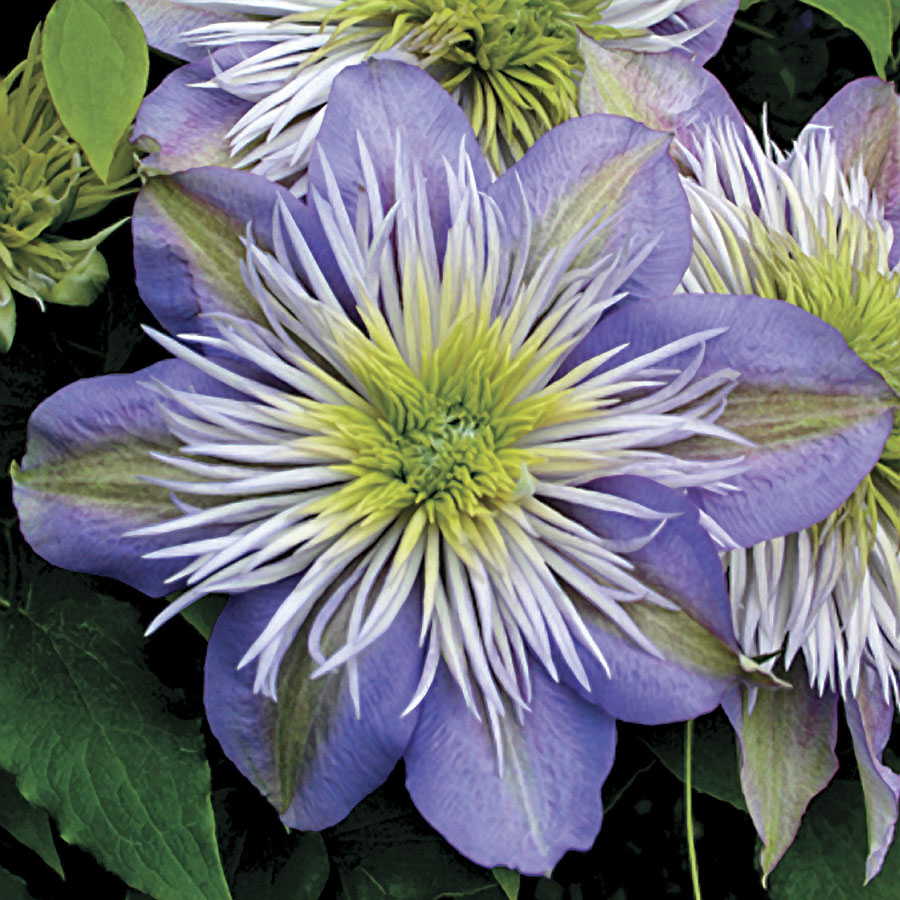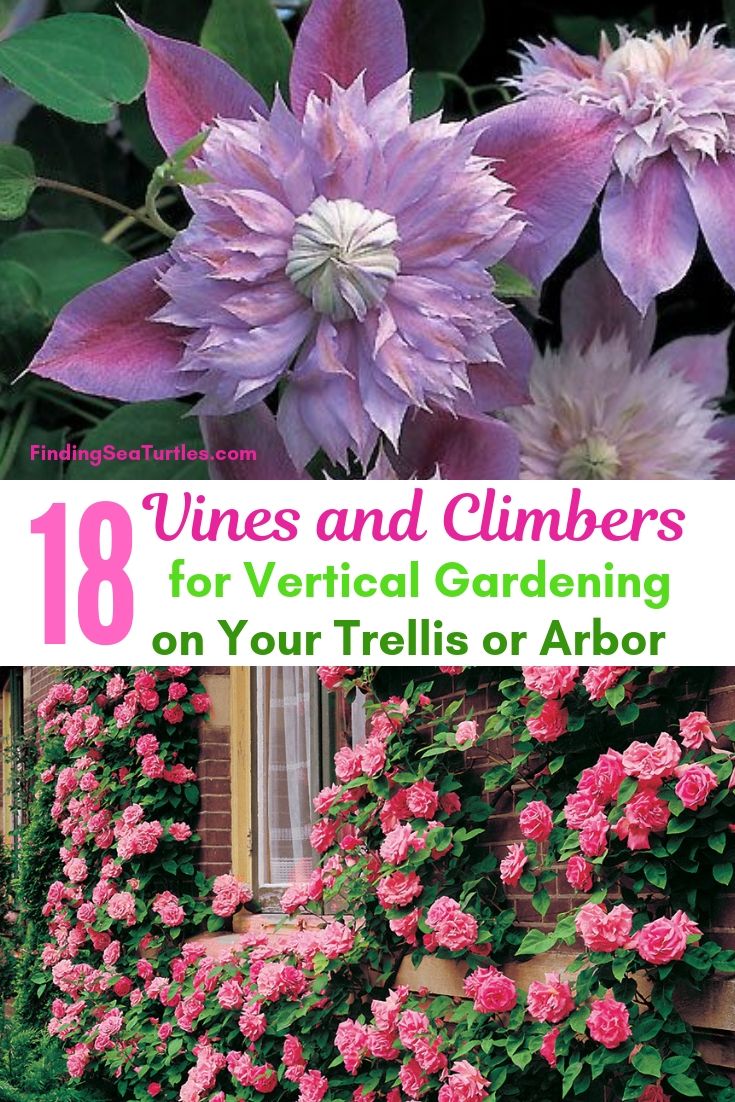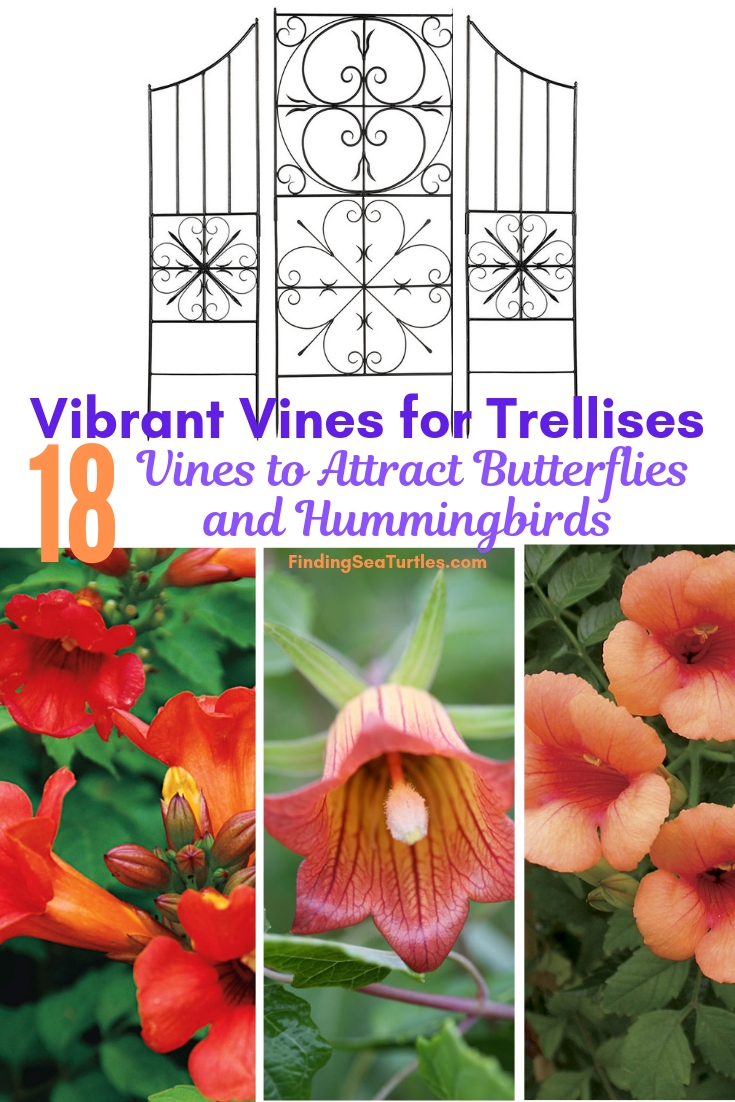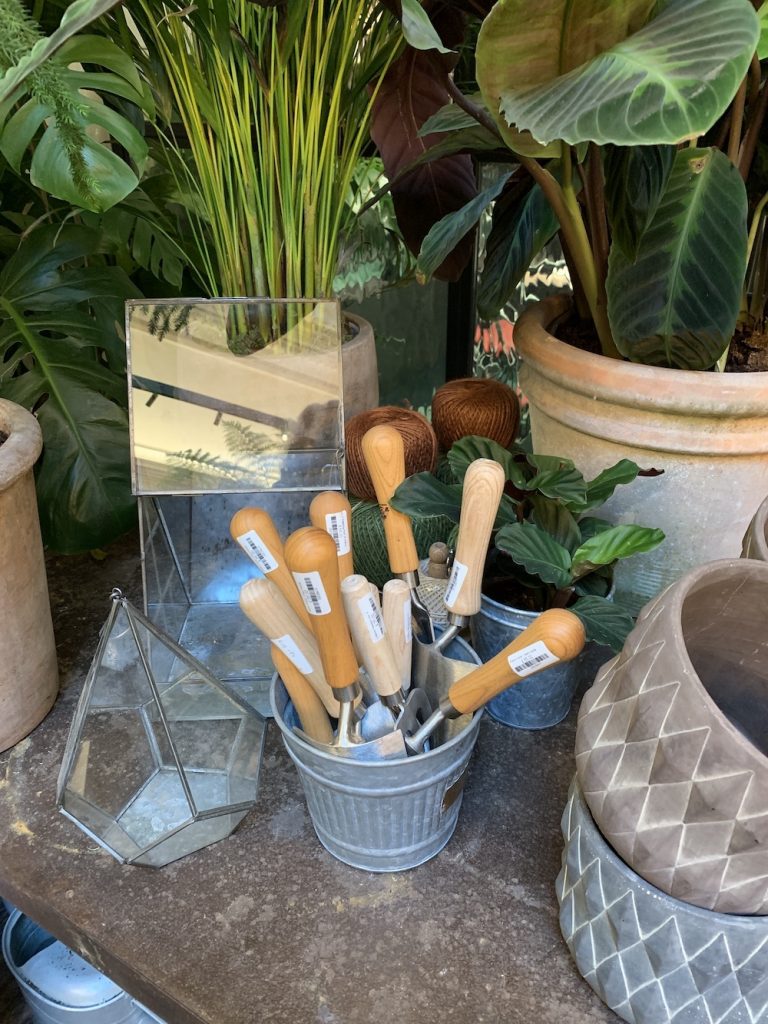18 Fabulous Flower Vines for Your Arbor, Trellis, or Pergola
Use flower vines and climbing plants to add drama to your garden or landscape. Add vertical interest with these gorgeous flower vines.
Flower vines provide vertical beauty to all gardens. But vines can also help create an outdoor garden room. The height of the vines act as screens to provide privacy to your outdoor living space. Vines and climbers can create a focal point among the other landscape plants. And many vines and climbers provide a nice fragrance to your garden area. Blooming vines, climbers, and vertical growing plants are available in many colors. Add vertical color for a dramatic display.
So, if you are searching for a climber for your arbor, trellis, or pergola, you have many to select from.
We’ve rounded up 18 vibrant flowering vines and climbers. Ideal for arbors, trellis, or pergolas. Fragrant, long blooming vines. Some hard working vines even bloom from late Spring into early Fall. Take a look. Be sure to tell us what you think.
-
Sweet Summer Love Clematis

Sweet Summer Love Clematis has starry blooms combine with deep red to magenta tones with rich, grape purples. A stunning multi-colored look. Cold hardy Sweet Summer Love has a sweet fragrance. Blooms early to late Summer. Grows in zones 4 to 9 in full Sun. Reaches 8 to 12 feet tall and 6 feet wide. Attracts butterflies and hummingbirds. Long blooming, fragrant climber. Ideal for trellises. Tolerant of humidity and heat conditions. Resists disease and pests.
Sweet Summer Love Clematis is from Szczepan Marczynski, the noted Polish breeder. Proper pruning improves the flowering season.
2. Josephine Regal Clematis

Josephine Regal Clematis has dramatic, double-flowered lilac blooms. Each bloom has a dark strip on the outer petal and pale ruff in the center. Blooms from June to September. Grows in zones 4 to 8 in part shade and part Sun to full Sun. Reaches 7 feet tall. The star of the 1998 Chelsea Flower Show.
3. Bees’ Jubilee Clematis

Bees’ Jubilee Clematis has 6 to 8 inch mauve pink flowers. Flowers have deep pink bars. Blooms from May to June and again in September. Grows in zones 5 to 8 in part shade and part Sun to full Sun. Reaches 6 to 8 feet tall. A compact clematis with showy flowers. Likes partial shade and partial Sun.
4. Samaritan Jo Clematis

Samaritan Jo Clematis has silvery pink edged purple blooms. Dark anthers are tipped in glowing citron. Blooms from June to July and again in September. Grows in zones 4 to 10 in mostly Sun to full Sun. Reaches 4 to 5 feet tall. Beneficial for pollinators and attracts butterflies. Long blooming and can be grown in containers. A compact grower. Named for volunteer work by Samaritans. All volunteers are referred to as Samaritan Jo.
5. Crystal Fountain Clematis

Crystal Fountain Clematis has blue and lavender double petals. Blooms have a frilly pom pom on top of a wide daisy-like ray of 5 inch petals. Blooms in late Spring to early Fall. Grows in zones 4-9 in full Sun. Reaches 6 feet tall and 3 feet wide. Attracts butterflies and hummingbirds. Long blooming. Tolerant of heat and humidity conditions. Resistant to disease, pests, and powdery mildew. Cold hardy. Plant in containers or garden borders. Highly prized, vigorous growing plant. Plant with a vertical or horizontal support for climbing. Provide a full Sun garden area where the roots are shaded. Use in cut floral arrangements. Provide support with a trellis or arbor.
6. Snowdrift Clematis

Discovered in China by plant collector E. H. Wilson, Snowdrift Clematis is stunning. Fragrant Snowdrift Clematis has tiny, white flowers against a dark foliage. Two inch blooms appear from mid to late Spring. Grow in zones 6-9 in part shade and part Sun to full Sun. Lush, hardy evergreen. Reaches 10 to 25 feet tall with 8 feet spread. Attracts butterflies. Tolerant of heat and humidity conditions. Resistant to disease and pests. Recommended to thread the vine through an open fence for support. A cold hardy, free-blooming perennial. Easy to maintain and rapid growing. Pruning recommended.
7. Scentsation Honeysuckle

Free flowering Scentsation Honeysuckle has showy cream and bright yellow blooms. Fragrant blooms appear in mid Spring and continue into Fall. A vining growth habit with a long blooming season. Grows in zones 4-9 in full Sun. Reaches 10 feet tall and 5 feet wide. Attracts bees, butterflies and hummingbirds. Tolerant of heat and humidity conditions. Resistant to deer, disease, and pests. Cold hardy and long blooming climber. Likes soil conditions that are moist and well-draining. Grow on a sturdy support structure such as a trellis, arbor, or pergola. Use as cut flowers. Bred in Herefordshire, England.
8. Goldflame Honeysuckle

Goldflame Honeysuckle has deep pink cluster blooms with a golden yellow interior. Fragrant blooms appear from Spring into Fall. Grows in zones 4 to 9 in part shade and part Sun to full Sun. Reaches 10 to 15 feet tall with a 3 to 6 feet spread. Beneficial for pollinators. Fast growing climber for a trellis or arbor. Can be maintain in a shrub-like form as well.
9. Campsis Summer Jazz Fire Trumpet Vine

Campsis Summer Jazz Fire Trumpet Vine has bright red-orange, trumpet-shaped flowers. Bright fire-breathing colors and semi-dwarf is ideal for a small trellis and fence. Blooms from Spring through Fall. Grows in zones 5 to 8 in full Sun. Reaches 6 to 8 feet tall and 4 to 5 feet wide. Beneficial to pollinators and bee friendly. Attracts birds, hummingbirds, and butterflies. Deer resistant. Plant in garden beds or borders. Award Winner with Fall color.
10. Campsis Indian Summer Trumpet Vine

Campsis Indian Summer Trumpet Vine produces masses of blooms. Blooms are soft shades of yellow with an orange-red center. A vigorous climber with trumpet-shaped blooms. Blooms appear in late spring and into mid Summer. Grows in zone 4 to 9 in part shade and part Sun to full Sun. Reaches 12 to 15 feet tall with a 3 to 5 feet spread. Attracts hummingbirds and butterflies. Deer and rabbit resistant. Resistant to disease and pests. Tolerant of drought, heat and humidity conditions. Award Winner vine that is native with a long blooming period. Pruning is recommended.
Indian Summer will cover fences, outbuildings, and arbors with its showy leaves and trumpet shaped blooms. Will not invade but vigorous and needs strong structure support. After blooming period ends, large 3 to 5 inch seed pods develop. Snip seed pods in late Summer to avoid seeding of trumpet vines. Use seed pods in dried floral arrangements.
11. Margarita Carolina Jessamine

A fragrant vine, Margarita Carolina Jessamine has yellow blossoms and glossy deep, evergreen foliage. Showy, bright yellow trumpet shaped blooms appear in 2 to 3 inch clusters. Blooms heavily in late Spring and early Summer. Grows in zones 6 to 9 in full Sun. Reaches 8 to 10 feet tall and 5 feet wide. Fragrance is a sweet scent of Jasmine. Plant in garden beds and borders. Grow in containers on patio or on a garden arbor. Use as a hedge. Tolerates some shade. Grow Margarita Carolina on mailbox post, lamppost, fences, trellises, and arbors. Tolerates poor soil conditions. Tolerant of heat and humidity conditions. Once established, tolerant of drought conditions. Resistant to deer and rabbits. Ideal for an entryway to greet guest with these wonderful fragrant flowers. Trim every 3 to 4 years as it becomes top-heavy.
12. Zephirine Drouhin Climbing Rose

Introduced in 1868. Zephirine Drouhin Climbing Rose is a romantic, fragrant, old-fashioned rose. Zephirine Drouhin has cerise carmine to magenta pink blooms with a rich damask scent. Blooms are ruffled, doubled old-fashioned rounded roses. Blooming season begins in Spring and continues to early Fall. Heaviest blooming is during cooler temperatures in Spring and Fall. Foliage is rich, dark green and new growth foliage is a coppery-purple color. Grows in zones 5 to 9 in part shade and part Sun to full Sun. Reaches 15 to 20 feet tall and 4 to 5 feet wide. Attracts butterflies. Cold hardy. Fragrant thornless double blooming heirloom rose. Resistant to disease and powdery mildew. Pruning recommended. Plant in garden borders or over a trellis or porch. Trim this old French Bourbon rose into a formal hedge. Use as cut flowers.
13. New Dawn Climbing Rose

New Dawn Climbing Rose has light pink fully double, ruffled blooms. Blooms are 3 to 4 inches wide. Delivers a light, sweet fragrance. Stems arise on tough, thorny canes. Grows in zones 5 to 9 in part shade and part Sun to full Sun. Reaches 18 to 20 feet high and up to 10 feet wide. Once established, tolerant of drought conditions. Resistant to disease. Plant in garden borders or in landscapes. Use blooms in cut flower arrangements. Grow against walls, framed windows, over arbors and pergolas.
The first rose ever to receive a US Plant Patent, New Dawn has been around for over 85 years. A revolutionary climbing rose when introduced in 1930. Considered the best rose for everblooming habit, disease resistant, flower power, and tolerance of light shade. Inducted into the Rose Hall of Fame 30 years ago.
14. Blue Moon Wisteria

Blue Moon is a vigorous, quick-growing fragrant vine. Showy large lilac-blue flowers appear in foot-long racemes like clusters of grapes. Blue Moon Wisteria racemes or flower clusters are 12 inches long. Blooms from early to late Summer. Grows in zones 3 to 9 in full Sun. Tops out at 25 feet long and 6 to 8 feet wide. Use Blue Moon Wisteria in cut floral arrangements. Ideal for growing across pergolas, arches, and trellises. Provide as much sunlight as possible. Likes moist, well-drained soil. Provide compost and organic material periodically.
Minnesota bred by Harvey and Brigitte Buchite. Cold hardy to -40°F.
15. Amethyst Falls Wisteria

Native Amethyst Falls Wisteria is a non-invasive Wisteria. A less vigorous easier to manage variety. Amethyst Falls has fragrant vividly blue flowers on 4 to 6 inch racemes or flower clusters. Blooms appear in Spring and repeat all Summer.
Grows in zones 5 to 9 in part shade and part Sun to full Sun. Reaches 30 feet high and 4 feet wide. First year bloomer. Amethyst Falls is resistant to deer, disease, and pests. Once established, tolerant of drought conditions. Tolerant of heat and humidity conditions. Foliage is disease-resistant. Award winner of the Georgia Gold Medal in 2006. Gorgeous vine is ideal for pergolas, trellises, fences, and arbors. Attracts butterflies all summer long. Can train as a free-standing tree. Prune late winter to shape or remove any unwanted growth.
16. Maypop Passionflower

Native Maypop Passion Flower has pastel shades of pink and purple. Widely-spaced petals are incurved. A central mass of frizzy strands provides ribbons of colors. Fragrant blooms begin in midsummer and continue until frost. Showy foliage that is 5 to 6 inches wide and 8 inches long. Egg-shaped edible fruit appears after flowering. Edible fruit is chartreuse and delicious. Grows in zones 5 to 11 in full Sun. Reaches 8 to 12 feet tall with a 3 to 6 feet spread. Easy to maintain. Can be grown in a container. Hardy to -25 degrees F.
17. Climbing Hydrangea

Cold hardy Climbing Hydrangea has white clouds of lace cap flowers with glossy, dark green foliage. Blooms early to mid Summer. Grows in zone 4 to 8 in part shade and part Sun to full Sun. Reaching 30 to 50 feet high with a 5 to 6 feet spread. Attracts butterflies. First year bloomer. Tolerant of heat and humidity. Resistant to deer as well as disease. Grow Climbing Hydrangea for privacy and as a garden border. Easy to grow and covers ground vertically or horizontally. Shaggy, cinnamon-colored bark is striking and provides Winter interest for the garden. Ideal to grow on north or east facing large trees or brick walls. Plant as a ground cover. Likes moist soil.
18. Canary Bellflower

Canary Bellflower has 3 inch long orangey-red bell shape flowers. Blooms all Winter long. Once blooming is done, walnut size orange fruits develop. Fruits are edible. Grows in zones 9b to 11 in part shade and part Sun. Reaches 6 to 10 feet long. Once established, tolerant of drought conditions. Tolerates shade. Attracts hummingbirds. Plant in containers. A Canary Islands native that produces tasty walnut-sized orange fruits.
These are 18 flower vines that can add vertical interest to your garden space. If you would like to start a vertical landscape, now is the time. If you try any of these vibrant vines and climbers, let us know how you make out. We’d love to hear about your vertical plants in your garden and yard.
Interested in gardening? If you found this helpful . . .
You May Also Enjoy some of our other gardening related posts.
15 Bee Friendly Perennials to Make Your Garden Buzz
16 Perennials That Attract Hummingbirds to Your Garden!
12 Perennials That Butterflies Find Irresistible
23 Fall Blooming Plants for Pollinators
And if you have any questions, feel free to reach out to us. We always are ready to help you out. Thank you for dropping by.
Mary


















